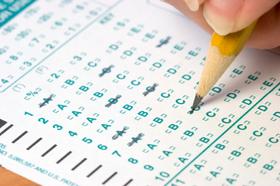I am writing this article about rubrics for parents. Your child's first couple of years in school will probably be an exciting time of exploration and discovery. Then, along come the middle and high school years when assessment begins to rear its ugly head. Then that day comes when your child comes home all upset because she got a C on a paragraph her class had to write on the prompt "Stuff that makes me laugh." Suddenly, the assessment is staring you and your child in the face. Both of you wonder why her teacher gave her a C.
Now, let's understand something fundamental to assessment. Your teachers are not trying to humiliate or demean you. They are merely trying to determine your child's skill sets. We adults have endured performance reviews during the course of our careers. Those are other forms of assessment. Teachers, by and large, don't grade subjectively. They look at a set of criteria which they apply uniformly to every student's work. Those criteria are styled rubrics. So, let's dig in and find out how they work. As we look at the various components that can make up rubrics, I have included an authoritative source from one of the many education schools in the nation. Use these to learn more about a specific rubric component that interests you.
Fundamental Principles of Rubrics
Assessment Tool
Essentially, a rubric is a tool for evaluating and assessing work or performance. Like we use Google Maps or Waze to tell us how to get from A to B, teachers use rubrics to evaluate their students' work. While rubrics sound formal and rigid, in practice, they can be quite flexible. One exercise may have four rubrics, while another exercise may have fewer. The teacher is looking for a specific result based on the criteria she has established for that particular exercise.
Rubrics can be simple or complex, or in educators' parlance, holistic or analytic. The following sources offer a detailed description of both types of rubrics. The links will give you access to a wealth of detailed explanations.
Holistic Rubric
"A holistic rubric is the most general kind. It lists three to five performance levels, along with a broad description of the characteristics that define each level." "
A holistic rubric provides students with a general overview of what is expected by describing the characteristics of a paper that would earn an 'A,' (or be marked 'excellent'), a B (or 'proficient') a C (or 'average') and so on."
Analytic Rubric
"An analytic rubric breaks down the objective into specific component parts. Every section is scored independently using a rating scale. The final score is comprised by adding each component part." "
An analytic rubric separates the characteristics of an assignment into parts, allowing the instructor to categorize and define exactly what each level of achievement looks like."
"A rubric is a scoring tool that explicitly describes the instructor's performance expectations for an assignment or piece of work."
This video offers an overview of rubrics as an assessment tool.
Criteria
As I mentioned above, rubrics define the specific criteria or parameters that the teacher wants to see. For example, that essay I mentioned earlier, the one where your child received a C, might have had a required length of 150 words. If your child turned in the exercise with only 50 words, that would reduce her score, as length would have been one of the parameters.
In K-12 schools that employ trained teachers, the protocols for rubrics will be clearly defined and understood. They become part of the school's pedagogical fabric. The consistent use of rubrics assumes significant importance in the high school years because college admissions staff know what a grade at a given school actually means when they see it on an academic transcript.
"Rubrics identify criteria: the aspects of performance (e.g., argument, evidence, clarity) that will be assessed"
Performance Levels
Typically, teachers will set different levels of performance for each criterion. The point here is uniformity; in other words, every student's work is treated the same.
"Levels of performance are typically divided into three- to six-point scales and given labels such as basic-proficient-advanced; needs improvement-meets expectations-exceeds expectations"
This video explains the difference between rubrics and a grading guide.
Descriptors
Rubrics provide descriptions of what each performance level looks like for each criterion. These descriptions will vary from simple to complex depending on the exercise being graded.
"Develop a clear and concise descriptor for each combination of criterion and performance level. These descriptors should provide examples or explanations of what constitutes each level of performance for each criterion."
Scoring System
The end result of building a rubric is the score. This is what the student and her parents see. Teachers determine scores based on performance levels.
"Rubrics can be used to provide feedback to students on diverse types of assignments, from papers, projects, and oral presentations to artistic performances and group projects."
Conclusion
While rubrics have many moving parts and range from the simple to the complex, they all have the same purpose: to help students understand what to expect on a given exercise and give teachers an objective way to assess the results. Teachers need to know that their lessons have been understood before moving on to the next lesson. As you can see from this discussion, rubrics provide an elastic framework capable of adapting to just about any subject being taught.
Questions? Contact us on Facebook. @publicschoolreview
#EducationAssessment #RubricsInTeaching #StudentEvaluation #TeachingTools #HolisticRubrics #AnalyticRubrics #publicschools












